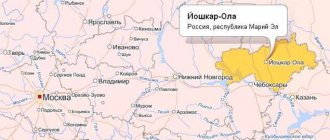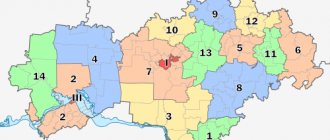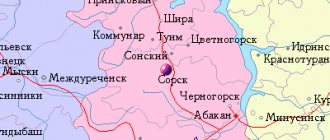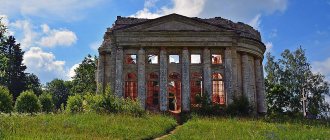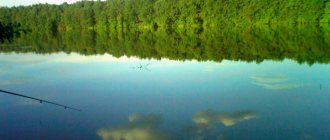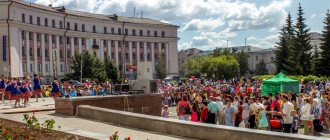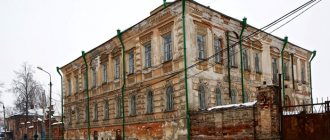Zvenigovo City
Zvenigovo is a city that is the administrative center of the Zvenigovo district of the Republic of Mari El. Zvenigovo officially received city status on July 10, 1974.
This city is located on the left bank of the river. Volga, in the area of the Kuibyshev reservoir, and is located 83 kilometers from the city of Cheboksary, 92 kilometers from the city of Yoshkar-Ola and 88 kilometers from Kazan.
According to official data, in 2010, 12,606 people lived in Zvenigovo.
Initially, on the site of the city there was a village of the same name. Over time, a small city was formed. The city owes its creation to the settlement of Chekura and the ship repair center.
The settlement of Chekura is a small Russian village on the right bank of the Volga, created as a transshipment point during the development of trade relations in the mid-19th century between Moscow, Kazan and Nizhny Novgorod. Subsequently, the city of Zvenigovo appeared, located on the opposite bank of the river.
At that time, the shipping business was developing rapidly, and on the site of the future city, the shipping joint-stock company “Druzhina” was organized. The company developed prosperously, and in 1860 it had 16 steamships on its balance sheet, of which 7 were passenger ships, 9 were towing ships. All ships sailed mainly between the cities of Rybinsk and Nizhny Novgorod.
To develop the business, the owners of the squad, two brothers named Shipov, rented land from the peasants in a wooded area. This land was ideal for a base for housing ships in winter and for creating a repair point.
In 1860, construction of the first ship workshop began here.
A little before this important event, a settlement appeared here - a settlement with the interesting name Chekura.
Over time, the brothers' business expanded its boundaries. In addition to industrial buildings, a church, trade establishments, a school for children, a hospital and even a pharmacy appeared.
Unfortunately, on the eve of the revolution in Russia, the business of the Druzhina shipping company stopped “going uphill”, and the brothers-owners decided to get rid of the ships and the mechanical plant that had already been built at that time.
After receiving all the documents, the new owner, merchant I. Tet, quickly sold all the equipment. What I didn’t have time to sell was burned in a fire. According to some reports, the merchant himself started the fire to receive an insurance payment.
It is known that the ashes were then bought by the local backwater manager A. Nikolaev, timber merchant A. Zimin and shipowner A. Ivanov. Gradually the plant was restored and production resumed. True, the owners were now producing small ships
for small shipowners of Kazan.
Soon the plant suffered another fire. And it was revived again, but by Komsomol members. According to their initiative, the plant was renamed “Krasny Volgar”.
By the way, with the advent of the plant, the area around it began to rapidly settle down. Chekurov residents moved here, as well as settlers from adjacent neighboring areas. By 1904, the backwater numbered more than 300 people living in earthen barracks.
In addition to the mechanical plant, a small glass production plant operated for a short time.
Let's go back to our time. Today the total area of the Zvenigovo district, consisting of the city of Zvenigovo and the village. Chuvash-Otary, about 497 hectares. All land is under the jurisdiction of the local administration.
There are 834 registered households in Zvenigovo, and 209 in Chuvash-Otary.
This region of the republic has an extremely diverse population: about 51 percent of the inhabitants are Mari, about 37 percent are Russian, 7 percent are Chuvash, as well as Tatars, Mordovians, Ukrainians and other nationalities.
In such a small city there are many enterprises, institutions, post offices and telecommunications, shops, libraries, kindergartens and schools, hospitals, swimming pools and stadiums. In general, the infrastructure is developed.
As you can see, this city is small, but, thanks to its convenient geographical location and hardworking population, it is full of prospects.
Population
| Population | ||||||||
| 1931[4] | 1939[4] | 1959[5] | 1970[6] | 1979[7] | 1989[8] | 1992[4] | 1996[4] | 1998[4] |
| 2500 | ↗5200 | ↗7213 | ↗8597 | ↗12 013 | ↗14 239 | ↗14 800 | ↘14 600 | ↘14 400 |
| 2000[4] | 2001[4] | 2002[9] | 2003[4] | 2005[4] | 2006[4] | 2007[4] | 2008[10] | 2009[11] |
| ↘14 200 | ↘14 100 | ↘12 722 | ↘12 700 | ↘12 500 | ↘12 400 | ↘12 300 | →12 300 | ↘12 179 |
| 2010[12] | 2011[4] | 2012[13] | 2013[14] | 2014[15] | 2015[16] | 2016[17] | 2017[18] | 2018[19] |
| ↘11 946 | ↘11 900 | ↘11 848 | ↘11 764 | ↘11 729 | ↘11 681 | ↘11 504 | ↘11 379 | ↘11 204 |
| 2019[20] | 2020[21] | 2021[2] | ||||||
| ↘11 049 | ↘10 904 | ↗10 966 | ||||||
As of January 1, 2021, in terms of population, the city was in 885th place out of 1116[22]cities of the Russian Federation[23].
Notes
- Zvenigov city administration (Russian). Date accessed: February 14, 2021.
- ↑ 12
The permanent population of the Russian Federation by municipalities as of January 1, 2021 (Russian). Date accessed: April 27, 2021. Archived May 2, 2021. - ↑ 1 2
Zvenigovo (backwater Chekursky, Zvenizhsky, Provoy) |
Native Vyatka (undefined)
. rodnaya-vyatka.ru. Date accessed: July 21, 2021. - ↑ 123456789101112
People's encyclopedia "My City". Zvenigovo - All-Union Population Census of 1959. The size of the urban population of the RSFSR, its territorial units, urban settlements and urban areas by gender (Russian). Demoscope Weekly. Access date: September 25, 2013. Archived April 28, 2013.
- All-Union Population Census of 1970 The size of the urban population of the RSFSR, its territorial units, urban settlements and urban areas by gender. (Russian). Demoscope Weekly. Access date: September 25, 2013. Archived April 28, 2013.
- All-Union Population Census of 1979 The size of the urban population of the RSFSR, its territorial units, urban settlements and urban areas by gender. (Russian). Demoscope Weekly. Access date: September 25, 2013. Archived April 28, 2013.
- All-Union population census of 1989. Urban population (undefined)
. Archived from the original on August 22, 2011. - All-Russian population census 2002. Volume. 1, table 4. Population of Russia, federal districts, constituent entities of the Russian Federation, districts, urban settlements, rural settlements - regional centers and rural settlements with a population of 3 thousand or more (Russian). Archived from the original on February 3, 2012.
- Cities of the Republic of Mari El (number of inhabitants - estimate as of January 1, 2008, thousand people) (Russian). Date accessed: May 21, 2021. Archived May 21, 2021.
- The size of the permanent population of the Russian Federation by cities, urban-type settlements and regions as of January 1, 2009 (Russian). Retrieved January 2, 2014. Archived January 2, 2014.
- All-Russian population census 2010. Population of cities, regions, urban and rural settlements
- Population of the Russian Federation by municipalities. Table 35. Estimation of the resident population as of January 1, 2012 (Russian). Retrieved May 31, 2014. Archived May 31, 2014.
- Population of the Russian Federation by municipalities as of January 1, 2013. - M.: Federal State Statistics Service Rosstat, 2013. - 528 p. (Table 33. Population of urban districts, municipal districts, urban and rural settlements, urban settlements, rural settlements) (Russian). Retrieved November 16, 2013. Archived November 16, 2013.
- Estimation of the resident population in municipalities of the Republic of Mari El as of January 1, 2014 (Russian). Retrieved April 1, 2014. Archived April 1, 2014.
- Population of the Russian Federation by municipalities as of January 1, 2015 (Russian). Access date: August 6, 2015. Archived August 6, 2015.
- Population of the Russian Federation by municipalities as of January 1, 2021 (Russian) (October 5, 2018). Date accessed: May 15, 2021. Archived May 8, 2021.
- Population of the Russian Federation by municipalities as of January 1, 2021 (Russian) (July 31, 2017). Retrieved July 31, 2021. Archived July 31, 2021.
- Population of the Russian Federation by municipalities as of January 1, 2021 (Russian). Retrieved July 25, 2018. Archived July 26, 2021.
- Population of the Russian Federation by municipalities as of January 1, 2021 (Russian). Date accessed: July 31, 2019. Archived May 2, 2021.
- Population of the Russian Federation by municipalities as of January 1, 2021 (Russian). Date accessed: October 17, 2021. Archived October 17, 2021.
- taking into account the cities of Crimea
- https://rosstat.gov.ru/storage/mediabank/bul_Chislen_nasel_MO-01-01-2021.rar Population of the Russian Federation by municipalities as of January 1, 2021 (1.85 Mb, 07/30/2021)
- Shipbuilding and ship repair plant named after. Butyakova S. N.
- Zvenigovsky city dairy plant. (unspecified)
(inaccessible link). Access date: September 30, 2012. Archived December 11, 2012.
General information about the city of Zvenigovo
Below is a map with satellite images, terrain and cadastral divisions. The tables provide some information about the city of Zvenigovo, taken from open sources, a list of cadastral blocks for this territory of the settlement and the surrounding area.
Geographical feature
| Parameter | Meaning |
| Number in GKGN | 11905 |
| Famous place names | Zaton Chekursky, Zvenigovsky, Zvenizhsky, Provoy |
| Year of foundation | 1860 |
| Area | Zvenigovsky |
| Municipality | urban settlement Zvenigovo |
| Territory | Lands of settlements |
| Area, ha | 497 |
| Population, people | 11379 |
| Postcode | 425022..425072 |
Cadastral division
Information about real estate objects in the territory of the “city of Zvenigovo” can be placed in the following cadastral blocks:
| Quarter 12:14:2501001 | |||
| Plots | 666 | 127 | |
| OKS | 541 | 35 | |
| Quarter 12:14:2501002 | |||
| Plots | 392 | 81 | |
| OKS | 275 | 10 | |
| Quarter 12:14:2502001 | |||
| Plots | 12 | 10 | |
| OKS | 6 | 1 | |
| Quarter 12:14:2502002 | |||
| Plots | 34 | 26 | |
| OKS | 26 | 4 | |
| Quarter 12:14:2502003 | |||
| Plots | 18 | 13 | |
| OKS | 14 | 5 | |
| Quarter 12:14:2502004 | |||
| Plots | 10 | 7 | |
| OKS | 7 | 1 | |
| Quarter 12:14:2502005 | |||
| Plots | 28 | 20 | |
| OKS | 18 | 7 | |
| Quarter 12:14:2502006 | |||
| Plots | 32 | 26 | |
| OKS | 24 | 10 | |
| Quarter 12:14:2502007 | |||
| Plots | 45 | 31 | |
| OKS | 33 | 4 | |
| Quarter 12:14:2502008 | |||
| Plots | 45 | 29 | |
| OKS | 37 | 4 | |
| Quarter 12:14:2502009 | |||
| Plots | 26 | 18 | |
| OKS | 31 | 4 | |
| Quarter 12:14:2502010 | |||
| Plots | 52 | 44 | |
| OKS | 28 | 4 | |
| Quarter 12:14:2502011 | |||
| Plots | 7 | 6 | |
| OKS | 1 | 1 | |
| Quarter 12:14:2502012 | |||
| Plots | 41 | 13 | |
| OKS | 32 | 1 | |
| Quarter 12:14:2502013 | |||
| Plots | 20 | 13 | |
| OKS | 25 | 3 | |
| Quarter 12:14:2502014 | |||
| Plots | 39 | 26 | |
| OKS | 33 | 1 | |
| Quarter 12:14:2502015 | |||
| Plots | 12 | 6 | |
| OKS | 12 | 1 | |
| Quarter 12:14:2502016 | |||
| Plots | 11 | 10 | |
| OKS | 6 | 3 | |
| Quarter 12:14:2502017 | |||
| Plots | 9 | 7 | |
| OKS | 10 | 2 | |
| Quarter 12:14:2502018 | |||
| Plots | 10 | 10 | |
| OKS | 12 | 1 | |
| Quarter 12:14:2502019 | |||
| Plots | 36 | 32 | |
| OKS | 26 | 6 | |
| Quarter 12:14:2502020 | |||
| Plots | 42 | 28 | |
| OKS | 38 | 3 | |
| Quarter 12:14:2502021 | |||
| Plots | 12 | 10 | |
| OKS | 9 | 3 | |
| Quarter 12:14:2502022 | |||
| Plots | 12 | 10 | |
| OKS | 9 | 0 | |
| Quarter 12:14:2502023 | |||
| Plots | 8 | 8 | |
| OKS | 4 | 1 | |
| Quarter 12:14:2502024 | |||
| Plots | 14 | 9 | |
| OKS | 17 | 2 | |
| Quarter 12:14:2502025 | |||
| Plots | 14 | 8 | |
| OKS | 13 | 0 | |
| Quarter 12:14:2503001 | |||
| Plots | 17 | 14 | |
| OKS | 31 | 1 | |
| Quarter 12:14:2503002 | |||
| Plots | 4 | 3 | |
| OKS | 1 | 0 | |
| Quarter 12:14:2503003 | |||
| Plots | 19 | 15 | |
| OKS | 21 | 0 | |
| Quarter 12:14:2503004 | |||
| Plots | 11 | 7 | |
| OKS | 10 | 1 | |
| Quarter 12:14:2503005 | |||
| Plots | 15 | 14 | |
| OKS | 9 | 1 | |
| Quarter 12:14:2503006 | |||
| Plots | 56 | 27 | |
| OKS | 50 | 4 | |
| Quarter 12:14:2503007 | |||
| Plots | 45 | 19 | |
| OKS | 50 | 2 | |
| Quarter 12:14:2503008 | |||
| Plots | 44 | 23 | |
| OKS | 25 | 0 | |
| Quarter 12:14:2503009 | |||
| Plots | 54 | 36 | |
| OKS | 49 | 3 | |
| Quarter 12:14:2503010 | |||
| Plots | 59 | 32 | |
| OKS | 56 | 4 | |
| Quarter 12:14:2503011 | |||
| Plots | 80 | 49 | |
| OKS | 61 | 10 | |
| Quarter 12:14:2503012 | |||
| Plots | 40 | 32 | |
| OKS | 35 | 4 | |
| Quarter 12:14:2503013 | |||
| Plots | 29 | 22 | |
| OKS | 29 | 4 | |
| Quarter 12:14:2503014 | |||
| Plots | 32 | 20 | |
| OKS | 28 | 1 | |
| Quarter 12:14:2503015 | |||
| Plots | 19 | 12 | |
| OKS | 20 | 3 | |
| Quarter 12:14:2503016 | |||
| Plots | 2 | 2 | |
| OKS | 0 | 0 | |
| Quarter 12:14:2504001 | |||
| Plots | 35 | 30 | |
| OKS | 21 | 3 | |
| Quarter 12:14:2504002 | |||
| Plots | 37 | 29 | |
| OKS | 38 | 6 | |
| Quarter 12:14:2504003 | |||
| Plots | 24 | 20 | |
| OKS | 25 | 4 | |
| Quarter 12:14:2504004 | |||
| Plots | 43 | 24 | |
| OKS | 48 | 4 | |
| Quarter 12:14:2504005 | |||
| Plots | 77 | 74 | |
| OKS | 118 | 96 | |
| Quarter 12:14:2504006 | |||
| Plots | 24 | 19 | |
| OKS | 20 | 3 | |
| Quarter 12:14:2504007 | |||
| Plots | 21 | 13 | |
| OKS | 19 | 3 | |
| Quarter 12:14:2504008 | |||
| Plots | 69 | 52 | |
| OKS | 63 | 9 | |
| Quarter 12:14:2504009 | |||
| Plots | 23 | 18 | |
| OKS | 9 | 0 | |
| Quarter 12:14:2504010 | |||
| Plots | 35 | 28 | |
| OKS | 26 | 10 | |
| Quarter 12:14:2504011 | |||
| Plots | 26 | 21 | |
| OKS | 18 | 1 | |
| Quarter 12:14:2504012 | |||
| Plots | 33 | 24 | |
| OKS | 32 | 5 | |
| Quarter 12:14:2504013 | |||
| Plots | 23 | 17 | |
| OKS | 20 | 2 | |
| Quarter 12:14:2504014 | |||
| Plots | 4 | 2 | |
| OKS | 5 | 0 | |
| Quarter 12:14:2504015 | |||
| Plots | 129 | 17 | |
| OKS | 113 | 5 | |
| Quarter 12:14:1304002 | |||
| Plots | 1244 | 348 | |
| OKS | 24 | 3 | |
| Quarter 12:14:1606003 | |||
| Plots | 2 | 2 | |
| OKS | 1 | 1 | |
In the table for objects: the first number is the total quantity, the second – with boundaries. For more detailed information, click on the cadastral quarter number.
Excerpt characterizing Zvenigovo
Everywhere he felt bad, but the worst thing was the familiar sofa in the office. This sofa was scary to him, probably because of the heavy thoughts that he changed his mind while lying on it. Nowhere was good, but the best place of all was the corner in the sofa behind the piano: he had never slept here before. Tikhon brought the bed with the waiter and began to set it up. - Not like that, not like that! - the prince shouted and moved it a quarter away from the corner, and then again closer. “Well, I’ve finally done everything over, now I’ll rest,” the prince thought and allowed Tikhon to undress himself. Frowning in annoyance from the efforts that had to be made to take off his caftan and trousers, the prince undressed, sank heavily onto the bed and seemed to be lost in thought, looking contemptuously at his yellow, withered legs. He didn’t think, but he hesitated in front of the difficulty ahead of him to lift those legs and move on the bed. “Oh, how hard it is! Oh, if only this work would end quickly, quickly, and you would let me go! - he thought. He pursed his lips and made this effort for the twentieth time and lay down. But as soon as he lay down, suddenly the whole bed moved evenly under him back and forth, as if breathing heavily and pushing. This happened to him almost every night. He opened his eyes that had closed. - No peace, damned ones! - he growled with anger at someone. “Yes, yes, there was something else important, I saved something very important for myself in bed at night. Valves? No, that's what he said. No, there was something in the living room. Princess Marya was lying about something. Desalle—that fool—was saying something. There’s something in my pocket, I don’t remember.” - Quiet! What did they talk about at dinner? - About the prince, Mikhail... - Shut up, shut up. “The prince slammed his hand on the table. - Yes! I know, a letter from Prince Andrei. Princess Marya was reading. Desalles said something about Vitebsk. Now I'll read it. He ordered the letter to be taken out of his pocket and a table with lemonade and a vitushka - a wax candle - to be moved towards the bed and, putting on his glasses, he began to read. Here only in the silence of the night, in the faint light from under the green cap, did he read the letter for the first time and for a moment understand its meaning. “The French are in Vitebsk, after four crossings they can be at Smolensk; maybe they’re already there.” - Quiet! - Tikhon jumped up. - No, no, no, no! - he shouted. He hid the letter under the candlestick and closed his eyes. And he imagined the Danube, a bright afternoon, reeds, a Russian camp, and he enters, he, a young general, without one wrinkle on his face, cheerful, cheerful, ruddy, into Potemkin’s painted tent, and a burning feeling of envy for his favorite, just as strong, as then, worries him. And he remembers all the words that were said then at his first Meeting with Potemkin. And he imagines a short, fat woman with yellowness in her fat face - Mother Empress, her smiles, words when she greeted him for the first time, and he remembers her own face on the hearse and that clash with Zubov, which was then with her coffin for the right to approach her hand. “Oh, quickly, quickly return to that time, and so that everything now ends as quickly as possible, as quickly as possible, so that they leave me alone!” Bald Mountains, the estate of Prince Nikolai Andreich Bolkonsky, was located sixty versts from Smolensk, behind it, and three versts from the Moscow road. On the same evening, as the prince gave orders to Alpatych, Desalles, having demanded a meeting with Princess Marya, informed her that since the prince was not entirely healthy and was not taking any measures for his safety, and from Prince Andrei’s letter it was clear that he was staying in Bald Mountains If it is unsafe, he respectfully advises her to write a letter with Alpatych to the head of the province in Smolensk with a request to notify her about the state of affairs and the extent of the danger to which Bald Mountains are exposed. Desalle wrote a letter to the governor for Princess Marya, which she signed, and this letter was given to Alpatych with the order to submit it to the governor and, in case of danger, to return as soon as possible. Having received all the orders, Alpatych, accompanied by his family, in a white feather hat (a princely gift), with a stick, just like the prince, went out to sit in a leather tent, packed with three well-fed Savras. The bell was tied up and the bells were covered with pieces of paper. The prince did not allow anyone to ride in Bald Mountains with a bell. But Alpatych loved bells and bells on a long journey. Alpatych's courtiers, a zemstvo, a clerk, a cook - black, white, two old women, a Cossack boy, coachmen and various servants saw him off. The daughter placed chintz down pillows behind him and under him. The old lady's sister-in-law secretly slipped the bundle. One of the coachmen gave him a hand. - Well, well, women's training! Women, women! - Alpatych said puffingly, patteringly exactly as the prince spoke, and sat down in the tent. Having given the last orders about the work to the zemstvo, and in this way not imitating the prince, Alpatych took off his hat from his bald head and crossed himself three times. - If anything... you will come back, Yakov Alpatych; For Christ’s sake, have pity on us,” his wife shouted to him, hinting at rumors about war and the enemy. “Women, women, women’s gatherings,” Alpatych said to himself and drove off, looking around at the fields, some with yellowed rye, some with thick, still green oats, some still black, which were just beginning to double. Alpatych rode along, admiring the rare spring harvest this year, looking closely at the strips of rye crops on which people were beginning to reap in some places, and made his economic considerations about sowing and harvesting and whether any princely order had been forgotten. Having fed him twice on the way, by the evening of August 4th Alpatych arrived in the city. On the way, Alpatych met and overtook convoys and troops. Approaching Smolensk, he heard distant shots, but these sounds did not strike him. What struck him most was that, approaching Smolensk, he saw a beautiful field of oats, which some soldiers were mowing, apparently for food, and in which they were camping; This circumstance struck Alpatych, but he soon forgot it, thinking about his business. All the interests of Alpatych’s life for more than thirty years were limited by the will of the prince alone, and he never left this circle. Everything that did not concern the execution of the prince’s orders not only did not interest him, but did not exist for Alpatych. Alpatych, having arrived in Smolensk on the evening of August 4th, stopped across the Dnieper, in the Gachensky suburb, at an inn, with the janitor Ferapontov, with whom he had been in the habit of staying for thirty years. Ferapontov, twelve years ago, with the light hand of Alpatych, having bought a grove from the prince, began trading and now had a house, an inn and a flour shop in the province. Ferapontov was a fat, black, red-haired forty-year-old man, with thick lips, a thick bumpy nose, the same bumps over his black, frowning eyebrows and a thick belly. Ferapontov, in a waistcoat and a cotton shirt, stood at a bench overlooking the street. Seeing Alpatych, he approached him. - Welcome, Yakov Alpatych. The people are from the city, and you are going to the city,” said the owner. - So, from the city? - said Alpatych. “And I say, people are stupid.” Everyone is afraid of the Frenchman. - Women's talk, women's talk! - said Alpatych. - That’s how I judge, Yakov Alpatych. I say there is an order that they won’t let him in, which means it’s true. And the men are asking for three rubles per cart - there is no cross on them! Yakov Alpatych listened inattentively. He demanded a samovar and hay for the horses and, having drunk tea, went to bed. All night long, troops moved past the inn on the street. The next day Alpatych put on a camisole, which he wore only in the city, and went about his business. The morning was sunny, and from eight o'clock it was already hot. An expensive day for harvesting grain, as Alpatych thought. Shots were heard outside the city from early morning.
Anomalous sights in Mari El
Strange and mysterious places are everywhere. Most importantly, people themselves endow them with mysticism. There are a lot of such places in the lands of the Mari. What else can you expect from an ancient people who still lives according to the Faith of their Ancestors?
Ovda-Korem ravine
- Address: village Nursola, Kuzhenersky district.
This place was once inhabited by ovdas - mysterious women with huge breasts. Their favorite pastime was riding horses, which they stole from local residents. Back in the middle of the last century, people found round passages that led underground to the dwellings of police officers. But then they disappeared. They say that widows are now hiding in the dense forests of the Kirov region.
Viy Pamash
- Coordinates: 56.911297, 48.739767.
The strange spring is located in the Novotoryalsky district. Despite the fact that its water cures many ailments, being around it can make you feel both good and bad. Water, depending on the time of day, has different energy.
Before lunch it is positive, and towards evening it changes to negative. Both have a healing effect, but they help against different diseases. In order not to aggravate the course of the disease, you need to know exactly what time of day you can draw water with maximum benefit.
